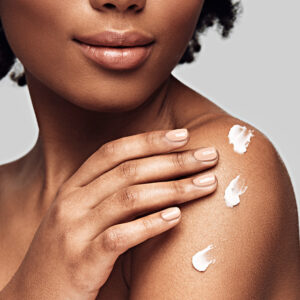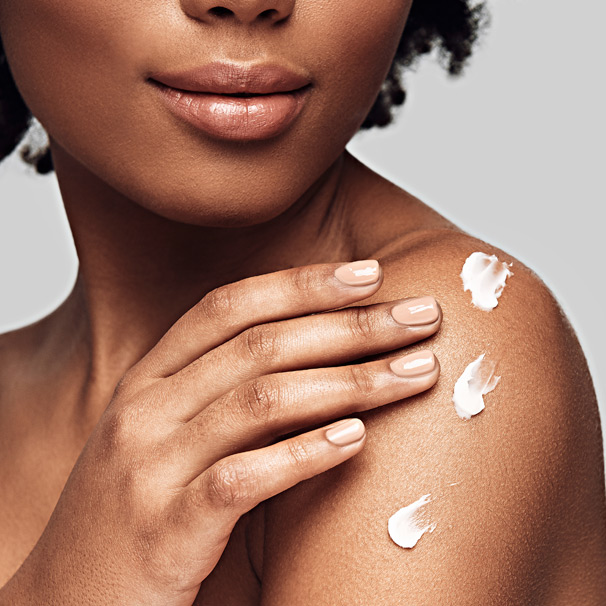Keratosis Pilaris
Chicken skin bumps - such a simple yet instantly identifiable description of the skin concern keratosis pilaris (commonly dubbed "KP"). Can't you just visualize it?
These minute, rough bumps with their grater-like texture are most frequently scattered along the upper arms and thighs. However, the cheeks, back and buttocks can all become involved at one time or another. They're annoying, embarrassing, unsightly, chronic and incredibly commonplace.
If you don't have this condition, odds are that you know somebody who does. Whenever I talk about KP, inevitably the individual with whom I'm conversing pauses, gasps, then exclaims "I didn't know that's what that was! My child, husband, co-worker (fill in the blank as appropriate) has that!"
Because keratosis pilaris affects one out of every two people worldwide this reaction isn’t surprising. KP is somewhat more common in children and adolescents; 50 to 80% of children have KP. Adults needn't feel neglected. Keratosis pilaris affects 4 out of every 10 adults, too. Women are slightly more prone to developing keratosis pilaris. Most people with KP are unaware that not only is there a designated medical term for the condition, but that treatment exists.
Keratosis pilaris is hereditary, inherited as an autosomal dominant gene. This is similar to the brown vs. blue eye color phenomenon. All it takes is a single gene from either parent to find oneself with less than perfectly smooth skin. But not everyone can point a finger at who's to blame since only 30 to 50 percent of KP patients have a positive family history.
In general, keratosis pilaris is aesthetically displeasing but medically harmless. And while always possible it might become more noticeable at puberty, it more often than not improves with age.
Excess skin cells build up around individual hair follicles. Sometimes a hair is unable to reach the surface and becomes trapped beneath the debris. During puberty, this is an ideal set-up for triggering follicular acne.
Keratosis pilaris creates havoc with the skin's surface as a raised, rough, bumpy texture and uneven nutmeg-grater appearance forms. It is often quite noticeable. Inflammation within each hair follicle can cause embarrassing pinpoint red or brown polka dots to form beneath each miniature mound of keratin. Seasonal fluctuations can be seen with improvement more likely during the summer.
Controlling Your Outer Self
Since keratosis pilaris is genetically predetermined, it may not be curable but should be controllable. There is no reason to passively take a wait and see approach. After all, there's no guarantee that you'll outgrow it. And while most with KP may not realize there really is something they can do about it, KP can really traumatize some sufferers.
Treatment is all about smoothing away the bumps. Therapy can eliminate the bumps, improve the texture, eliminate acne-causing plugs and improve the overall appearance. Chemical exfoliation needn't be fraught with irritation, redness or discomfort.
- Glycolic Acid
An array of alpha hydroxy acids (AHAs) are utilized in a dermatologist's quest to smooth out keratosis pilaris. Glycolic and lactic acids work as chemical exfoliating agents. Dermatologists often turn to OTC and Rx lactic acid products to palliate KP. Medically effective buffered glycolic acid works best as it’s better tolerated and longer lasting. - Urea
Urea is one of those special little known ingredients used by dermatologists to dramatically soften the crustiest of skin concerns. Urea is a humectant – it draws moisture from the air to hydrate the skin. It is an awesome additive in improving the appearance of KP. KP Duty dermatologist formulated AHA moisturizing therapy for dry skin contains urea to help restore moisture up to 218% to the skin with the help of this dermatologist favorite. - Vitamin A Treatments
Patients may turn to prescription vitamin A creams to help restore a smooth texture in recalcitrant cases or as a way to help treat keratosis pilaris complicated by acne. Potent over the counter retinols (up to 1%) are another option. Poetry in Lotion can add that extra something to smoothing out skin if you’re a KP retinol devotee. Overeager use won't help hasten silky skin. Instead it can leave the skin parched, peeling and painful. A tiny dab every other night is more than adequate for beginners. - Scrubs, Rubs and Peels
True, scrubbing at dry, bumpy skin makes skin smoother. But it doesn't entirely eliminate the signs of KP or those embarrassing little pink polka dots. That’s what using KP Duty is for. But prepping with a scrub, a series of microdermabrasions or even getting a chemical peel can certainly jumpstart your way to smoothness, especially as we get nearer to sleeveless weather. KP Duty body scrub has just the right blend of physical and chemical exfoliation to hasten smoothness and prep for your favorite treatment. - Immunomodulators
Since keratosis pilaris is often thought of as a manifestation of eczema, it stands to reason that new prescription medications may play a role in treating keratosis pilaris. I tend to reserve this for more complex cases or for the patient who already has a tube at home, occasional use may be a helpful, off label option.
The KP Duty Family
DERMAdoctor's KP Duty family is clinically proven to improve the appearance of dry skin and rough, red chicken skin bumps (like Keratosis Pilaris). It primes, soothes and smoothes dry, bumpy skin. Going sleeveless never looked so good.
KP duty dermatologist formulated AHA moisturizing therapy for dry skin
Active moisturizing complex combines dermatologist strength buffered glycolic acid with urea, a powerful humectant, to smooth and hydrate even the driest skin. Green tea helps targets the source of unsightly red skin discoloration.
Results of KP Duty use over the 6 week period:
- 94% of users showed a clinical improvement.
- Up to an 84% reduction in redness and inflammation.
- Up to a 218% increase in skin hydration.
KP duty dermatologist body scrub with chemical + physical exfoliation
Dermatologist recommended chemical exfoliants dissolve the glue that cements superficial skin cells together. Smooth, non-abrasive synthetic beads lift away dead skin cells. Skin is resurfaced and retexturized; leaving it soft, smooth and radiant.
- KP duty body scrub allows dermatologist-recommended skin therapies to provide deeper, more thorough results.
- Helps prep skin for self-tanning and post-bathing treatments (including body acne, keratosis pilaris, dry skin concerns, shaving bumps, ingrown hairs and bleaching).
- Ideal for most skin types. Not recommended for ultra-sensitive skin.
Treatment for keratosis pilaris is ongoing - if discontinued, skin begins reforming around hair follicles. Maintenance is the best way to maintain silky smooth skin. Letting your keratosis pilaris show is unnecessary and so easy to control. Get ready for sleeveless fashion now and look your absolute best!
Thank you for taking the time to read my newsletter. I hope you have found it informative.
Audrey Kunin, M.D.
This content is sponsored by DERMAdoctor. The author receives compensation for its creation. All content is the legal copyright of DERMAdoctor, Inc, and it may not be used, reprinted, or published without written consent. The information provided is for entertainment purposes only and is not intended to provide medical, legal or other professional advice.



I have a few bumps on the back of my arms but mostly it looks likes an allergic reaction or a blotchy sunburn. It has been diagnosed as keratosis pilaris. What would you suggest for a routine to reduce the redness?
Thank you,
Julie
You can use the once or twice weekly. You may use your favorite cleanser at other times or even after using the scrub if you like.
All My Best!
Dr. Audrey Kunin
The information contained in this response is intended for educational purposes only and is not meant to be used as a diagnosis or treatment plan. If you have a medical concern, please contact your physician.
Interesting thought; however, keratosis pilaris isn't so much an issue of the presence of the hair. The problem is that the skin is genetically programmed to produce too many skin cells about each hair follicle which creates the rough, bumpy texture. For the inflammation at the base of the hair follicles, I'm not certain whether the presence or absence of the hair itself is responsible for the inflammation, making laser treatment's benefit there an unanswered question. Intruiging, and much appreciated question.
All My Best!
Dr. Audrey Kunin
The information contained in this response is intended for educational purposes only and is not meant to be used as a diagnosis or treatment plan. If you have a medical concern, please contact your physician.